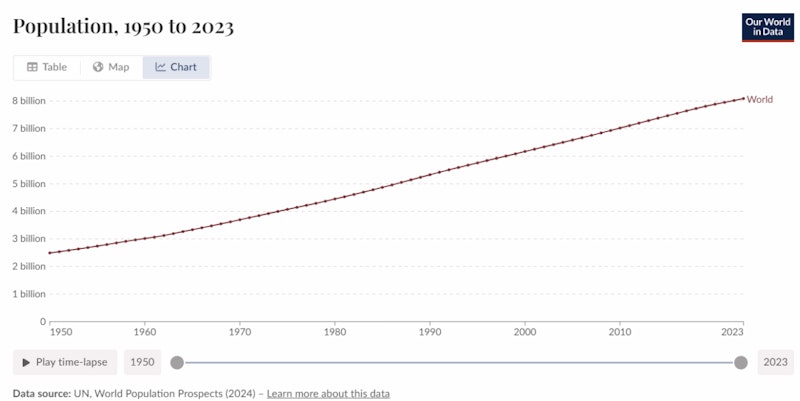Study Notes
GCSE Geography | What is Urbanisation? (Urbanisation 1)
- Level:
- GCSE
Last updated 23 Feb 2025
Urbanisation means the 'increasing proportion of a country’s population living in urban areas'. This process happened in high-income countries (HICS) following the Industrial Revolution – newly emerging economies (NEEs) and low-income countries (LICs) have urbanised much more recently.
The global pattern of population change
The world’s population has grown dramatically since the 19th century, and is still growing...
1900 - 1.6 billion people
1950 - 2.49 billion people
1960 - 3.02 billion people
1970 - 3.7 billion people
1980 - 4.45 billion people
1990 - 5.55 billion people
2000 - 6.17 billion people
2010 - 7.02 billion people
2020 - 7.89 billion people
You can seen this trend on the map from Our World in Data below - and if you use this link you see the animated version, and can add different countries and regions to compare population growth - https://ourworldindata.org/pop...

Patterns of urban growth
As the global population has increased, the proportion of people living in urban areas has also increased. Since 2010 more people in the world live in towns and cities than in rural areas. In 2023, 57% of the global population was urban - 4.61 billion people, compared to 3.45 billion rural dwellers.
The map from Our World in Data below shows this change over time - and again you can view the interactive version on their website - https://ourworldindata.org/urb...

HICs often have a high proportion of people living in cities - usually between 80-90% of the population. This is because people moved to urban areas to find work when the country industrialised in the past. This has resulted in crowded cities with thousands of high-rise buildings and skyscrapers. Hong Kong (pictured below) has the most with over 9,000 high-rise buildings, including 4,000 skyscrapers that stand taller than 100m, and with 554 buildings above 150m (source: Council on Tall Buildings and Urban Habitat).
Now the rate of growth of these cities has slowed down and some cities are even seeing a decrease in their population size. This is due to counter-urbanisation - the process of people are moving out of the cities to the countryside where they think their quality of life will be better. Many people now live in the countryside and commute to work in the city.
LICs tend to have a much lower proportion of people living in cities - usually between 30-40% of the population, however many of these cities are now growing rapidly, followed the pattern seen in NEEs such as Nigeria, Brazil, India and China, which have all rapidly urbanised since the 1980s.

Why does urbanisation happen?
Rural-to-urban migration
Urban areas may grow because people move to them from other countries (international migration) or from other places in the same country (internal migration). When people move to towns and cities from the rural areas (the countryside) it is known as rural–urban migration and is the result of push and pull factors...
Push factors - reasons for people to leave a place, e.g. poverty, crop failure, conflict, lack of access to education and health care, poor water/electricity supply, etc.
Pull factors - reasons for people to move to a place and the perceived idea of a better quality of life, e.g. job opportunities, better access to education and healthcare, to join family members, etc.
Natural increase
If the birth rate in a town or city is higher than the death rate, the population will increase. The death rate has dropped in urban areas around the world due to residents having access to a varied diet, better access to clean water and sanitation systems, and more access to healthcare facilities - there is a marked difference in quality of life between urban and rural areas in NEEs and LICs. Additionally, many of the people who move from rural areas to urban areas are young adults, so will often go on to have children, which pushes the birth rate up.
Rapid urban growth means that millions of people across the globe live in blocks like the one below, or in informal settlements (see separate notes).

You might also like

Cities - Urban Ingenuity and Regeneration
19th July 2011
Gentrification
Study Notes

Big Data and Planning for an Urban World
12th December 2015

Changing Places - Urban Farms in London
26th October 2017

Rush hour in Los Angeles
16th February 2018
Mapping company identifies the real locations of the UKs largest cities.
24th February 2018